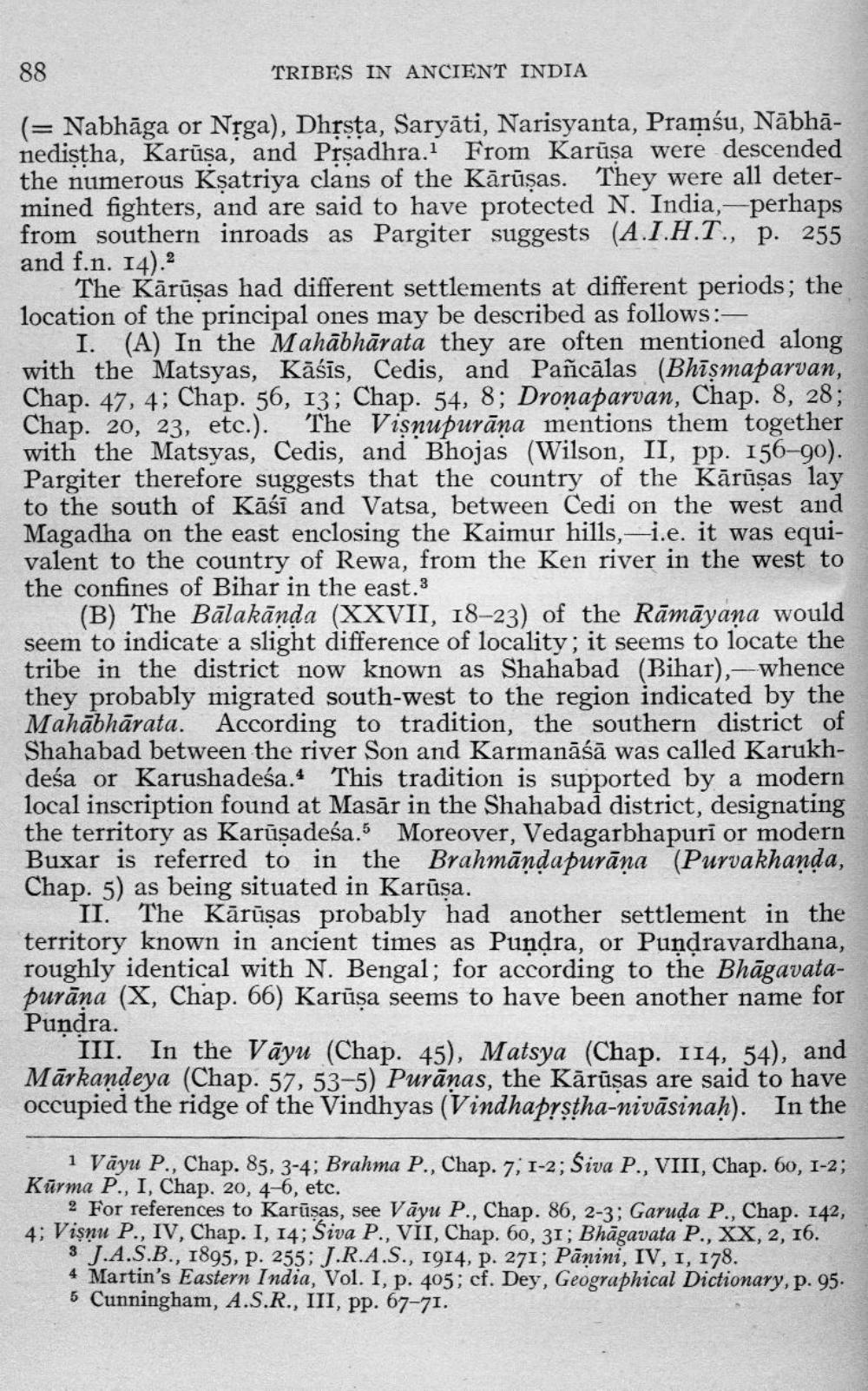________________
88
TRIBES IN ANCIENT INDIA (= Nabhāga or Nrga), Dhrsta, Saryāti, Narisyanta, Prambu, Nābhānedistha, Karūsa, and Prsadhra. From Karūşa were descended the numerous Ksatriya clans of the Kārūşas. They were all determined fighters, and are said to have protected N. India, -perhaps from southern inroads as Pargiter suggests (A.I.H.T., p. 255 and f.n. 14).2
The Kārūsas had different settlements at different periods; the location of the principal ones may be described as follows:
I. (A) In the Mahābhārata they are often mentioned along with the Matsyas, Kāśīs, Cedis, and Pañcālas (Bhīşmaparvan, Chap. 47, 4; Chap. 56, 13; Chap. 54, 8; Dronaparvan, Chap. 8, 28; Chap. 20, 23, etc.). The Visnupurāna mentions them together with the Matsyas, Cedis, and Bhojas (Wilson, II, pp. 156-90). Pargiter therefore suggests that the country of the Kārūsas lay to the south of Kāśi and Vatsa, between Cedi on the west and Magadha on the east enclosing the Kaimur hills, -i.e. it was equivalent to the country of Rewa, from the Ken river in the west to the confines of Bihar in the east.3
(B) The Bālakānda (XXVII, 18-23) of the Rāmāyaṇa would seem to indicate a slight difference of locality; it seems to locate the tribe in the district now known as Shahabad (Bihar),-whence they probably migrated south-west to the region indicated by the Mahābhārata. According to tradition, the southern district of Shahabad between the river Son and Karmanāśā was called Karukhdeśa or Karushadeśa. This tradition is supported by a modern local inscription found at Masār in the Shahabad district, designating the territory as Karūşadeśa. Moreover, Vedagarbhapuri or modern Buxar is referred to in the Brahmāndapurāna (Purvakhanda, Chap. 5) as being situated in Karūsa.
II. The Kārūsas probably had another settlement in the territory known in ancient times as Pundra, or Pundravardhana, roughly identical with N. Bengal; for according to the Bhāgavatapurāna (X, Chap. 66) Karūsa seems to have been another name for Pundra.
III. In the Vāyu (Chap. 45), Matsya (Chap. 114, 54), and Mārkandeya (Chap. 57, 53-5) Purānas, the Kārūsas are said to have occupied the ridge of the Vindhyas (Vindhaprstha-nivāsinah). In the
i Vāyu P., Chap. 85, 3-4; Brahma P., Chap. 7; 1-2; Śiva P., VIII, Chap. 60, 1-2; Kūrma P., I, Chap. 20, 4-6, etc.
2 For references to Karūsas, see Vāyu P., Chap. 86, 2-3; Garuda P., Chap. 142, 4; Vişnu P., IV, Chap. I, 14; Śiva P., VII, Chap. 60, 31; Bhāgavata P., XX, 2, 16.
3 J.A.S.B., 1895, p. 255: J.R.A.S., 1914, p. 271; Pānini, IV, I, 178. 4 Martin's Eastern India, Vol. I, p. 405; cf. Dey, Geographical Dictionary, p. 95. 5 Cunningham, A.S.R., III, pp. 67-71.




